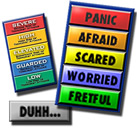This week I was, in turn, amused, maddened and fasincated by disaster. I had the opportunity to do both leadership and followership as officials from the “Seattle Urban Area” considered projects to submit for grant funding from the fedgov Department of Homeland Insecurity.
This whole process is a look into the little-known culture of “homeland insecurity” which has blossomed over the last 7 years.
Let me say, right at the beginning, that September 11th, 2001, was a horrific event and a real wake-up call for the United States. We’ve been taught the same lesson we learned on December 7th, 1941 – two huge oceans do not make for a nation secure from the enemies of our way of life. My somewhat humorous tone in this blog is not meant to make light of the serious threats we face.
But what is our major response? Pretty typically, we create a giant bureaucracy, slosh a lot of political rhetoric and some money around, and get prepared to fight … the last war.
The major bureaucracy is, of course, the Department of Homeland Security, or Insecurity, as I’ve named it, because it heads an industry and set of programs based upon the fear and feelings of insecurity of the American People. DHS is really a myriad of individual bureaucracies and programs, sometimes working at cross-purposes and often duplicating effort.
But I stray from the subject – the Urban Area Security Initiative (UASI), usually pronounced You-Ah-Zee. In 2009 about $1.8 billion will be granted to urban areas through a series of programs as shown here. The UASI grants are made to “urban areas”, a carefully defined (by the fedgov) set of metropolitan areas which share vulnerabilities and threats. The “Seattle Urban Area” is the City of Seattle, its surrounding King County, and the counties to the north and south. The Seattle urban area is eligible for $11 million, more or less, of that $1.8 billion pie.
Now $11 million may sound like a lot of money, and it is. But think about the Seattle Urban Area – a population of 3 million people, two major ports (Seattle and Tacoma) into which ships with nuclear bombs or bioterrorism agents or chemical weapons could sail, three major military bases (Naval Station Everett, McChord Air Force Base, Fort Lewis), and vulnerability to a potential magnitude 8.0 earthquake. We probably have 12,000 cops and firefighters (Seattle alone has 2,200), each of which needs radios and hazmat gear and training. All of a sudden, $11 million doesn’t sound like a lot, and it isn’t.
Its also a little amazing that places like Vermont and Wyoming – not exactly your typical terrorist or disaster targets – get $6 million each. But that’s the reality of politics in our 2009 world with two senators from every state and a lot of dollars to be allocated.
Each year, a group of officials from the emergency management, law enforcement, firefighting, public health and technology disciplines – the officials responsible to prepare the region for disasters and terrorist events – get together to consider projects for UASI funding. We did that this week in the Seattle Urban Area. We have a strategy to guide us but it is still a give-and-take to determine which projects are most importnat to the region.
I lead the subgroup of technical and operational staff responsible to consider and prioritize interoperable communications projects. These are the networks and systems which allow first, second and third responders to communicate with each other and with their dispatch centers to prepare for and respond to disasters large and small. They include handheld and vehicle-mounted radios, computer and telephone systems, and fiber optic networks.
Small disasters are the ones which occur every day – such as when I fell off my bicycle, shattered my arm and called 911 for help. The large ones are the fires, landslides, earthquakes, and (God forbid) terrorist events which may afflict our region.
Finding projects which prepare us for those disasters and which fit into $11 million is daunting. In the past we’ve procured fireboats and helicopters and personal protective equipment. We’ve found money for training our responders, buying radios and for public outreach and disaster preparedness campaigns. It is hard work to winnow 100 proposed projects and $40 million in needs down to a dozen or so projects with $11 million or so, but we mostly did it this week. In future blog entries I’ll talk about some of those projects – the ones I can reveal without making us more vulnerable to terrorists (and that is most of them).
In the meantime, I’m just proud of the emergency managers, fire and police officials, and technical staff I was able to spend time with this week, prioritizing projects to keep the Seattle urban area safe.
And I’m tired!



